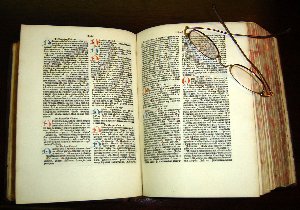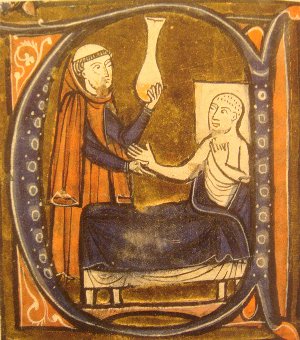Medicine
Explain how Europe benefited from cultural diffusion during the period c. A.D. 1000 - 1500.

A Latin copy of the Canon of Medicine, dated 1484, located at the P.I. Nixon Medical Historical Library of The University of Texas Health Science Center at San Antonio.
Muslim physicians made many important additions to the body of medical knowledge which they inherited from the Greeks. The Islamic doctors began by collecting all the medical observations and logic of Hippocrates and his followers, and Galen. However,they went on to much more practical observations and really managed to find some useful cures for some diseases. Medieval Islamic doctors were especially good at treating eye infections and eye problems like cataracts.
The great contribution of the Arabs was to put the study of medicine on a scientific footing and eliminate superstition and harmful folk-practices. Medicine was considered a highly technical calling, and one which required long study and training. Elaborate codes were formulated to regulate the professional conduct of doctors.
It was not enough to have a mastery of one's subject in order to practice medicine. Certain moral qualities were mandatory. It was said that a doctor should be kind, understanding, friendly, good, able to endure insults and adverse criticism; he must keep his hair short, and his fingernails as well; he must wear clean, white clothes and behave with dignity.
Before doctors could practice, they had to pass an examination, and if they passed they had to take the Hippocratic oath, which, if neglected, could lead to dismissal.
Hospitals were similarly organized. The large one built in Córdoba, Spain, was provided with running water and baths, and had different sections for the treatment of various diseases, each of which was headed by a specialist. Hospitals were required to be open 24 hours a day to handle emergency cases, and could not turn any patient away.
Ibn Sina - Avicenna
Ibn Sina wrote almost 450 treatises on a wide range of subjects, of which around 240 have survived. In particular, 150 of his surviving treatises concentrate on philosophy and 40 of them concentrate on medicine.
His most famous works are The Book of Healing, a vast philosophical and scientific encyclopaedia, and The Canon of Medicine, which is an encyclopedia of diseases, naming their causes and their symptoms, and suggesting treatments.
The Canon of Medicine was based on the work of Hippocrates and Galen, but Ibn Sina did not just repeat what people already knew. He wrote down his own new ideas too. For instance, he thought that tuberculosis was catching, even though most Europeans at that time thought it was not (but Ibn Sina was right).
The Canon of Medicine became the standard medical text at many medieval universities and was used as a text - book in the universities of Montpellier and Louvain as late as 1650.
Ibn Sina is regarded as a father of early modern medicine, and clinical pharmacology particularly for the following:
- his introduction of systematic experimentation and quantification into the study of physiology
- his discovery of the contagious nature of infectious diseases
- the introduction of quarantine to limit the spread of contagious diseases
- the introduction of experimental medicine
- evidence-based medicine
- clinical trials
- randomized controlled trials
- efficacy tests
- clinical pharmacology
- neuropsychiatry
- risk factor analysis and the idea of a syndrome
- the importance of dietetics and the influence of climate and environment on health
Abu al-Qasim al-Zahrawi
He authored a book of illustrated surgical techniques, the first of its kind, which was used in Europe for centuries.
Al-Zahrawi was the most famous surgeon of the Middle Ages. He was court physician of al-Hakam II, His great work, the Tasrif, was translated into Latin by Gerard of Cremona and became a leading medical text in European universities in the later Middle Ages.
The section on surgery contains a number of illustrations of surgical instruments of elegant, functional design and great precision. It describes lithotrites, amputations, ophthalmic and dental surgery and the treatment of wounds and fractures.

European depiction of the Arab doctor Al-Razi, in Gerardus Cremonensis Recueil des traités de médecine
1250-1260.
Muhammad ibn Zakariya ar-Razi - al-Razi
Al-Razi wrote a book distinguising the difference between measles and smallpox. He also explained that a fever was not part of the illness, but the body's way of fighting the illness (even though Europeans at this time thought that fevers were caused by having too much blood, and they used to bleed people to cure the fever).
Ibn Nafis
Ibn Nafis was the first scientist to describe how blood goes from your heart to your lungs to get air and then distributes the air all over your body. (The Roman doctor Galen had suggested some ideas, but Ibn Nafis showed that Galen's ideas were wrong).
Maimonides
Maimonides, who was Jewish and not a Muslim, was the sultan Saladin's doctor in the 1100's AD. Maimonides' book about medicine became very famous. It emphasized prevention - living a healthy life so you would not get sick.
